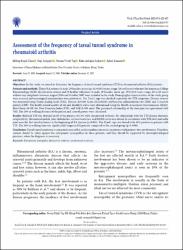| dc.contributor.author | Kalçık Ünan, Mehtap | |
| dc.contributor.author | Ardıçoğlu, Özge | |
| dc.contributor.author | Pıhtılı Taş, Nevsun | |
| dc.contributor.author | Aydoğan Baykara, Rabia | |
| dc.contributor.author | Kamanlı, Ayhan | |
| dc.date.accessioned | 2022-04-25T11:16:13Z | |
| dc.date.available | 2022-04-25T11:16:13Z | |
| dc.date.issued | 2021 | en_US |
| dc.identifier.citation | Ünan, M. K., Ardıçoğlu, Ö., Taş, N. P., Baykara, R. A., & Kamanlı, A. (2021). Assessment of the frequency of tarsal tunnel syndrome in rheumatoid arthritis. Turkish Journal of Physical Medicine & Rehabilitation (2587-1250), 67(4). | en_US |
| dc.identifier.uri | 10.5606/tftrd.2021.6797 | |
| dc.identifier.uri | https://hdl.handle.net/20.500.12899/1038 | |
| dc.description.abstract | Objectives: In this study, we aimed to determine the frequency of tarsal tunnel syndrome (TTS) in rheumatoid arthritis (RA) patients.
Patients and methods: Thirty RA patients (1 male, 29 females; mean age: 41.9±10.1 years; range, 26 to 65 years) who met the American College
Rheumatology (ACR) classification criteria and 20 healthy volunteers (1 male, 19 females; mean age: 39.3±10.8 years; range, 26 to 60 years)
without any complaints between August 2006 and October 2007 were included in the study. Demographic characteristics of the study group
were assessed and neurological examinations were performed. The Tinel’s sign was checked to provoke the TTS symptoms. Disease severity
was measured using Visual Analog Scale (VAS), Disease Activity Score-28 (DAS28), erythrocyte sedimentation rate (ESR) and C-reactive
protein (CRP). The health-related quality of life and disability status were determined using the Health Assessment Questionnaire (HAQ),
Short Form 36 (SF-36), Foot Function Index (FFI), and VAS (0-100 mm). The positional relationship of the foot pain was questioned with
VAS. The 100-m walking distance of the patient and control groups were calculated.
Results: Bilateral TTS was detected in 10 of the patients (33.3%) with rheumatoid arthritis. No relationship with the TTS disease duration,
seropositivity, rheumatoid nodule, joint deformities, corticosteroid use, and DAS28 score were found. In correlation with TTS, foot and ankle
joint were the first involved joints at the beginning of RA disease (p<0.005). The Tinel’s sign was found to be 45% positive in patients with
TTS. The 100-m walking time was significantly longer in RA patients compared to the control group (p<0.0001).
Conclusion: Tarsal tunnel syndrome is commonly seen in RA and its incidence increases in patients with primary foot involvement. Therefore,
caution should be taken against the entrapment neuropathies in these patients, and they should be supported by electrophysiological
practices, when the diagnosis is necessary | en_US |
| dc.language.iso | en | en_US |
| dc.rights | info:eu-repo/semantics/openAccess | en_US |
| dc.subject | Entrapment neuropathy | en_US |
| dc.subject | heumatoid arthritis | en_US |
| dc.subject | tarsal tunnel syndrome | en_US |
| dc.title | Assessment of the frequency of tarsal tunnel syndrome in rheumatoid arthritis | en_US |
| dc.type | Article | en_US |
| dc.department | MTÖ Üniversitesi, Tıp Fakültesi, Dahili Tıp Bilimleri Bölümü | en_US |
| dc.institutionauthor | Aydoğan Baykara, Rabia | |
| dc.identifier.doi | 10.5606/tftrd.2021.6797 | |
| dc.identifier.volume | 67 | en_US |
| dc.identifier.issue | 4 | en_US |
| dc.identifier.startpage | 421 | en_US |
| dc.identifier.endpage | 427 | en_US |
| dc.relation.publicationcategory | Makale - Uluslararası Hakemli Dergi - Kurum Öğretim Elemanı | en_US |


















